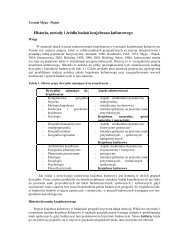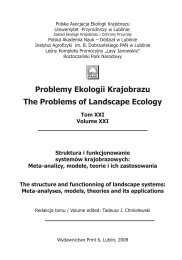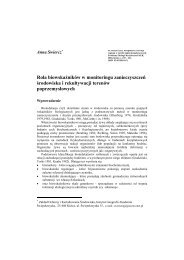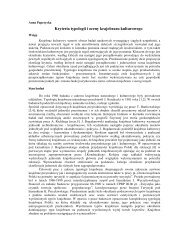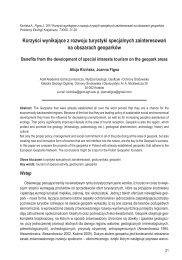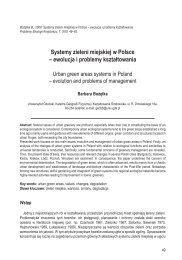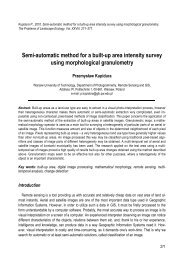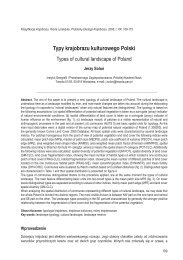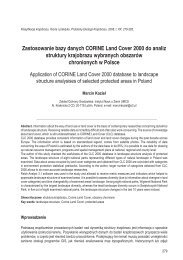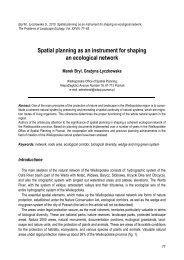Estimation of the area of sealed soil using GIS technology and ...
Estimation of the area of sealed soil using GIS technology and ...
Estimation of the area of sealed soil using GIS technology and ...
You also want an ePaper? Increase the reach of your titles
YUMPU automatically turns print PDFs into web optimized ePapers that Google loves.
<strong>Estimation</strong> <strong>of</strong> <strong>the</strong> <strong>area</strong> <strong>of</strong> <strong>sealed</strong>...<br />
1. Determination <strong>of</strong> built-up <strong>area</strong> classes according to an intensity <strong>of</strong> terrain cover <strong>and</strong> by functions –<br />
It should rely on a specific <strong>of</strong> <strong>the</strong> <strong>area</strong> <strong>of</strong> interest.<br />
2. Measure <strong>of</strong> a percentage <strong>of</strong> <strong>sealed</strong> <strong>soil</strong> for mentioned classes <strong>using</strong> several representative examples<br />
– might be completed <strong>using</strong> aerial or satellite images, management plans <strong>and</strong> base maps or topographic<br />
maps.<br />
3. Identification <strong>of</strong> borders <strong>of</strong> zones <strong>of</strong> different built-up classes <strong>and</strong> measure <strong>of</strong> <strong>the</strong>ir <strong>area</strong>s – preferably<br />
<strong>using</strong> satellite images.<br />
4. Calculation <strong>of</strong> <strong>the</strong> <strong>area</strong> <strong>of</strong> <strong>sealed</strong> <strong>soil</strong> for different zones <strong>and</strong> <strong>the</strong>n for total <strong>area</strong>.<br />
Warsaw city pilot <strong>area</strong><br />
Seven different classes <strong>of</strong> built-up <strong>area</strong> according to an intensity <strong>of</strong> terrain cover <strong>and</strong> by functions have<br />
been extracted:<br />
• very high intensity – old cities, traditional bordering buildings (tenement-houses with annexes, with<br />
“wells”),<br />
• high intensity – bordering buildings along streets <strong>and</strong> with green <strong>area</strong>s inside,<br />
• high intensity – industrial <strong>area</strong>s,<br />
• medium density – blocks scattered in green <strong>area</strong>s,<br />
• medium density – public domain,<br />
• low density – residential ho<strong>using</strong>,<br />
• very low density – green <strong>area</strong>s.<br />
A percentage <strong>of</strong> <strong>sealed</strong> <strong>soil</strong> for each class have been determined <strong>using</strong> topographic maps (scale<br />
1 : 10 000) <strong>and</strong>, independently, base city maps (scale 1 : 500). Several samples for different built-up <strong>area</strong><br />
classes are presented in figures 2–5. The comparison <strong>of</strong> <strong>the</strong> results obtained <strong>using</strong> <strong>the</strong>se different scale<br />
maps showed an insignificant differences between <strong>the</strong>m. They are presented in <strong>the</strong> table 1.<br />
Table 1. The percentage <strong>of</strong> <strong>sealed</strong> <strong>soil</strong> in different built-up <strong>area</strong> classes according to <strong>the</strong> samples measured on <strong>the</strong><br />
base city maps <strong>and</strong> topographic maps<br />
Class <strong>of</strong> built-up <strong>area</strong><br />
Sealed <strong>area</strong> after<br />
city map<br />
[%]<br />
Sealed <strong>area</strong> after<br />
topographic map<br />
[%]<br />
Absolute difference<br />
[%]<br />
Very high density 96 97 1<br />
Very high density (industrial zones) 91 98 7<br />
High density (bordering buildings) 74 79 5<br />
High density (public domain) 75 78 3<br />
Medium density (blocks) 52 47 5<br />
Low density 26 23 3<br />
Very low density 20 20 0<br />
255



